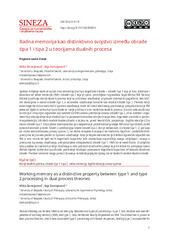Prikaz osnovnih podataka o dokumentu
Radna memorija kao distinktivno svojstvo između obrade tipa 1 i tipa 2 u teorijama dualnih procesa
Working memory as a distinctive property between type 1 and type 2 processing in dual process theories
| dc.creator | Damnjanović, Milica | |
| dc.creator | Damnjanović, Kaja | |
| dc.date.accessioned | 2023-12-08T11:57:43Z | |
| dc.date.available | 2023-12-08T11:57:43Z | |
| dc.date.issued | 2023 | |
| dc.identifier.issn | 2712-1291 | |
| dc.identifier.issn | 2712-1259 | |
| dc.identifier.uri | http://reff.f.bg.ac.rs/handle/123456789/5620 | |
| dc.description.abstract | Ljudsko mišljenje može se opisati kroz interakciju dva tipa kognitivne obrade – obrade tipa 1 koja je brza, intuitivna i nezavisna od radne memorije (RM) i obrade tipa 2 koja je spora, promišljena i ograničena kapacitetima RM. Na ovoj distinkciji počivaju teorije dualnih procesa koje su pristrasno rasuđivanje pripisivale sistematski pogrešnim, heuristič-kim intuicijama u osnovi obrade tipa 1, a racionalno rasuđivanje tumačile kao rezultat obrade tipa 2. Premda noviji nalazi sugerišu da normativistički ispravno rasuđivanje može biti ishod intuitivnog procesiranja, pretpostavka da je RM jedna od ključnih razlika dva tipa obrade se i dalje prožima u svim modelima dualnih procesa. U ovom radu analizirani su teorijski i empirijski argumenti koji svedoče da RM svakako predstavlja osnovu obrade tipa 2, ali su izneseni i argu-menti koji obaraju ideju da je obrada tipa 1 u potpunosti nezavisna od njenih kapaciteta. Argumenti proističu iz postav-ki najaktuelnijih, hibridnih modela dualne obrade, u kojima se, pored heurističkih, prepoznaju i logičke intuicije (LI) u osnovi obrade tipa 1. Kroz njihovu konceptualizaciju omogućena je problematizacija uloge RM u dva tipa obrade, usled njihove dvostruke prirode. Ishodi LI predstavljaju ishode obrade tipa 2, dok je mehanizam LI obrada tipa 1. LI počivaju na visoko automatizovanoj umnoj opremi, tj. na dobro usvojenom znanju o normativnim, logičkim i probabilističkim principima koji su neophodni za ispravno rasuđivanje. Kako je stepen automatizacije direktno ograničen kapacitetima RM, u tom smislu da ljudi većih kognitivnih kapaciteta brže akumuliraju najrazličitija znanja, uključujući i znanja o principima ispravnog rasuđivanja, pretpostavljena ortogonalnost obrade tipa 1 i RM čini se neodrživom. U zaključku rada pružene su smernice za dalja istraživanja u vidu preciznih istraživačkih pitanja koja bi trebalo da preispitaju status RM kao ključne razlike dva tipa obrade, podrobnije istražujući povezanost kognitivnih kapaciteta i efikasnosti intuitivne obrade. Pružene smernice mogu pomoći stvaranju verodostojnijeg teorijskog okvira budućih modela dualne obrade | sr |
| dc.description.abstract | Human thinking can be described as an interplay between two types of processing – type 1, fast, intuitive and non-dependent of working memory (WM), and type 2, slow, deliberate heavily dependent on WM. This distinction is pivotal in dual process theories, which have associated type 1 processing with biased responses, holding type 2 accountable for rational reasoning. Although newer findings suggest that intuitive processing can yield normatively correct responses, the assumption that WM represents the key differentiator of two types of reasoning still pervades through all dual process theories. In this paper, we provide arguments which support the idea that WM represents the underlying mechanism of type 2 processing, yet we point out the arguments which refute the idea that type 1 processing is non-dependent of its resources. The arguments stem from hybrid models of dual processes which, in addition to commonly recognized heuristic intuitions, propose logical intuitions (LI) as products of type 1 processing. LI enable direct problematization of the role of WM in two types of processing due to their dual nature. Outcomes of LI represent outcomes of type 2 processing, while their mechanism is type 1 processing. LI are based upon automatized mindware, i.e. on well-acquired knowledge regarding normative, logical and probabilistic principles which are necessary for sound reasoning. Given that the automatization level is directly constrained by WM, in a way that people with higher cognitive abilities accumulate a wide variety of knowledge much easier and faster, the assumed orthogonality of type 1 processing and WM seems unsustainable. At the end, we provide guidelines for future research that need to review the status of WM as the key differentiator between two types of processing by investigating the relationship between cognitive capacity and intuitive processing. Guidelines should help yield a more credible framework for future models of dual processes. | sr |
| dc.language.iso | sr | sr |
| dc.rights | openAccess | sr |
| dc.rights.uri | https://creativecommons.org/licenses/by/4.0/ | |
| dc.source | Sineza: časopis za humanističke i društvene nauke | sr |
| dc.subject | teorije dualnih procesa | sr |
| dc.subject | obrada tipa 1 i tipa 2 | sr |
| dc.subject | radna memorija | sr |
| dc.subject | logičke intuicije | sr |
| dc.subject | umna oprema | sr |
| dc.subject | dual process theories | sr |
| dc.subject | type 1 and type 2 processing | sr |
| dc.subject | working memory | sr |
| dc.subject | logical intuitions | sr |
| dc.subject | mindware | sr |
| dc.title | Radna memorija kao distinktivno svojstvo između obrade tipa 1 i tipa 2 u teorijama dualnih procesa | sr |
| dc.title | Working memory as a distinctive property between type 1 and type 2 processing in dual process theories | sr |
| dc.type | article | sr |
| dc.rights.license | BY | sr |
| dc.citation.epage | 25 | |
| dc.citation.issue | 3 | |
| dc.citation.spage | 7 | |
| dc.citation.volume | 4 | |
| dc.identifier.doi | https://doi.org/10.7251/SIN2303001D | |
| dc.identifier.fulltext | http://reff.f.bg.ac.rs/bitstream/id/14257/bitstream_14257.pdf | |
| dc.type.version | publishedVersion | sr |

